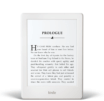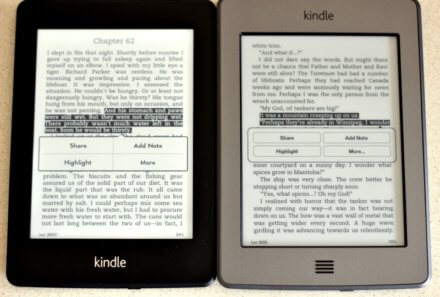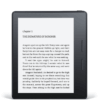Software
All Kindle eReaders share the same software, so the difference mostly lies in hardware. This means that, while every Kindle has the same basic DNA as far as software goes, each performs differently due to their unique configurations.
Ecosystem
Amazon’s Kindle devices are often praised for their unparalleled eBook ecosystem. All Kindle devices flawlessly integrates Amazon’s own eBook store, possibly the largest eBook store in the business. A self-sustaining cycle springs to life out of the platform’s popularity; readers flock to Amazon for the unbeatable number of titles available in their store, publishers flock to Amazon for the size of its market, and Amazon gets a healthy collection of books under its belt.
 1st Place9.8 out of 10
1st Place9.8 out of 10But what if the cycle fails?
Despite Amazon’s confidence in its store, avid readers must be aware of what they’re signing up for when they choose a Kindle. The thing about eBook readers is that there is no true “universal” eBook format. Much like the USA’s dedication to the Fahrenheit in a world that prefers the Celsius, Amazon fails to support the most common eBook formats used in the industry—namely, ePub and Adobe DRM files. This holds true for any Kindle product – Paperwhite included.
Because of the conflict in file types supported by different eBook readers, choosing an eBook reader from a particular company decides what eBook ecosystem you’ll be supporting. If you buy a Kindle now, books you purchased for your Kindle aren’t likely to be supported by, say, a Kobo eReader that you are planning to switch to in the future.
Yes, you can technically convert file formats, but you’ll have to jump through several hoops. Converting the files won’t guarantee quality either. Formatting can get messed up in the process, for example.
Aside from Amazon, you won’t find much trouble with other companies. It’s only really Amazon that refuses to support ePub files directly. You’ll want to stick to Kindles for the rest of your years if you buy one, but with Amazon holding strong in the eBook Store front, you won’t have to worry about the company (and consequently, its ecosystem) leaving you up in the air.
Readability
In 2015, Amazon decided to grace its readers with default font faces that don’t, well, suck. Now every Kindle eBook reader has Bookerly and Ember, renowned fonts that balances modernity with readability—great for readers out there who are sick of outdated fonts with cramped letters.
User Interface
The Kindle home screen is cleaner this time around. It prominently displays your current book alongside Goodreads recommendations, so you’ll never run out of books you’ll want to read.
Come to think of it, Kindle’s software experience is mainly the reason why the eReaders have many fans. Reading with a Kindle is a delight for curious souls; simply tap on a word to pull up the dictionary, Wikipedia, or the Kindle’s “X-Ray” window. And believe it, you’ll fall in love with the X-Ray feature within a few minutes of use. It reminds you of what you learn as you progress through your book. Character sheets, special terms—remember it all without the fear of spoilers!
Bugs/Issues
Because of the recent updates on the entry-level Kindle, the Kindle 2019 has slightly more software features compared to the Kindle Paperwhite. Its updated screen is also quicker to register touch (you’d have to apply slightly more pressure with the Paperwhite).
Additionally, heads up if you buy the 3G enabled Kindle Paperwhite. The free 3G connectivity is only covered up to the borders of the U.S., so don’t waste extra cash for the 3G enabled Paperwhite if you live outside the U.S.
On second thought, you might want to reconsider signing up for the 3G even if you live in the U.S.; you’d need Wi-Fi access to download books outside the Amazon store.
Hardware
There’s not a lot of observable differences between Kindle eReaders (save for perhaps the Kindle Oasis). Added to the fact that the software in each device are the same, you have to think of which features is worth paying for. Compared to others in the Kindle lineup, however, the Kindle Paperwhite offers one of the best bang for your buck.
The entry-level Kindle offers the basic Kindle experience. Like other E-ink screens, it performs spectacularly under direct sunlight, but this particular Kindle makes it difficult to read in the dark. Disappointing for night reading. Adding just $40 gets you the more useful Kindle Paperwhite. Unlike the entry-level Kindle, this eReader sports a screen resolution and pixel density on par with pricier eReaders. Plus, its built-in lights let you read in any lighting condition.
| KINDLE PAPERWHITE | |
|---|---|
| Price | $119.99 (with ads) |
| Built-in Light | 4 LEDs |
| Page Turns | Touchscreen |
| Resolution | 1448 x 1072 (300 ppi) |
| Waterproof/Dustproof | – |
| Charging cover | – |
| Advertised Battery Life | Weeks |
| Connectivity | WiFi / 3G |
| Supported Formats | PDF, MOBI, Kindle Format 8 (AZW3), Kindle (AZW) |
| Weight |
|
| Dimensions | 6.7″ x 4.6″ x 0.36″ |
| Screen size | 6” |
| Storage (on board) | 4GB |
| Connectors | Micro USB |
| Cloud Storage | Yes |
Display
True to its name, the entry-level Kindle is nowhere near the Paperwhite’s crisp, paper-like quality. The leap to a 1448×1072 screen resolution paired with a 300ppi pixel density allows the Kindle Paperwhite to provide a more richer experience thanks to sharper text and images. Its built-in light, meanwhile, allows you to read in the dark—a quality which brings most people to favor the Paperwhite as the best eBook reader you will ever need.
eReaders gain their popularity for several reasons, one of which is its display. Unlike the backlight of smartphones and tablets, e-ink screens don’t cause any eye strain even when you’re reading in the dark, in which the Kindle Paperwhite fulfills very well. They also don’t have that annoying glare tablets do, so you can read in any condition, under the sun or under the stars.
Ergonomics
The Kindle Paperwhite shares the same boxy look as the classic Kindles before it, but in light of Amazon’s changes to the entry-level Kindle, there’s a good chance they’ll update the Paperwhite’s design toward a slimmer, slightly rounded from. The Paperwhite’s the heaviest of the Kindle lot but as said, that may soon change. Still, its current form is still portable and comfortable to hold.
Flaws
This is only a minor issue, but some people found that light peeked through a bit unevenly at the top and bottom edge of the screen. It’s barely noticeable, but a few readers find it distracting (though that may just be the perfectionistic nature of some readers rearing its ugly head).
Like the entry-level Kindle, the Kindle Paperwhite relies solely on its touchscreen for turning pages. Since the only difference between the Kindles is the hardware, don’t expect PagePress and page turn buttons to trickle down to the cheaper models, but, of course, it would still be nice to have – especially since the pure touchscreen experience that the Kindle Paperwhite offers can sometimes be a tad inconvenient.
What's the Verdict on Kindle Paperwhite?
Kindle Paperwhite Review 2020 – Conclusion
You’ve read it before and it begs to be said again: the Kindle Paperwhite is the eReader with the best value from the Kindle line. Now considered as Amazon’s benchmark eReader, buying a Kindle Paperwhite will give you weeks of excellent reading. It may not have PagePress features or physical buttons for easier navigation, but it still does what it’s made for admirably well: providing a top notch reading experience. Despite the few minor flaws, the Kindle Paperwhite is definitely a serious contender for the most bang for the buck eBook reader in the market.









No Comments... Yet!